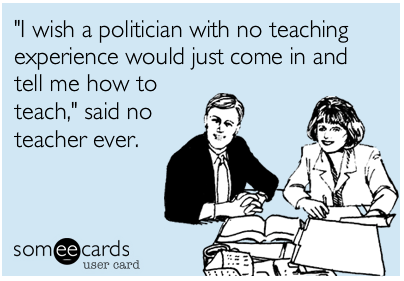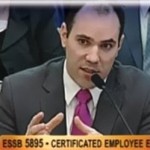You’ve seen the cartoons. They’re very popular on teachers’ Facebook pages:
- A politician holding up a blank slate with the message, “This is the number of policy decisions teachers made when we gave them the chance.”
- A teacher standing in front of a class of politicians, one of whom is asking, “How do I know a good teacher from a bad teacher?”
- Two politicians at the water cooler, eyes downcast, with the caption, “‘I wish a teacher with no policy making experience would just come in and tell me how to govern,’ said no elected official ever.”
OK, not really. Each is the inverse of a real cartoon that actually does get passed around – like the one accompanying this post. And each of the real cartoons expresses the frustration of teachers tasked to execute policies into which we had no say. The cartoon above drips with irony suggesting that if teaching were so easy, even a politician could do it.
But how good will teachers be at making policy? Or, for that matter, even advising policy makers?
Right now the message of the teacher leader movement, of which I consider myself a member, is that teachers deserve a voice, a place at the table. Heck, we deserve to set the table. And the message is gaining ground. Every teacher I know, upon hearing of the teacher leader movement, has been an instant and enthusiastic supporter, as has every parent.
So I claim our time is coming.
The claim is not that we’re near a tipping point in teacher-led education policy. Nor is it that our efforts in claiming a voice should diminish. Rather, the claim is that we should start preparing for the next step by paying attention to Andy Hargreaves and Dennis Shirley.
In Chapter 2 of their book The Global Fourth Way: The Quest for Education Excellence, they review how organizational experts like Charles Handy and Peter Senge use the Sigmoid curve as a model of the growth and collapse of a product. Initially, there is slow and unsteady growth, but as the product catches on, acceptance increases at a rapid pace before leveling off and finally collapsing.
The key to avoiding the collapse is that, “It is before, not after an organization has improved its existing product as much as it has been able, that it needs to be inventing new ones.”
What’s true for products may be true for teacher leadership. Our voices are growing and we are forming networks and exploiting social media to great effect. Our means of advocating for teacher led policy continue to improve, but is not at its peak.
Yet, now is the time to invent new ideas – about the policies we long to help craft. Because if teacher leaders, local and national, don’t have concrete and actionable policy ideas in hand and ready to promote, our movement will fall off the cliff.
Think of hot button issues in education: Standardized testing, teacher evaluation, Common Core, compensation, charter schools, and so forth. It won’t do to say we just want to do what’s right for kids, or want policies that support and don’t punish struggling teachers. We will have to name them to claim them.
And we have to be ready to argue among ourselves, compromise, and make decisions when all options are bad. And we have to be ready to do it all in public.
Some teachers are already there, informing policy makers and serving on policy making boards. I’m going find out what those pathfinders have to say.









